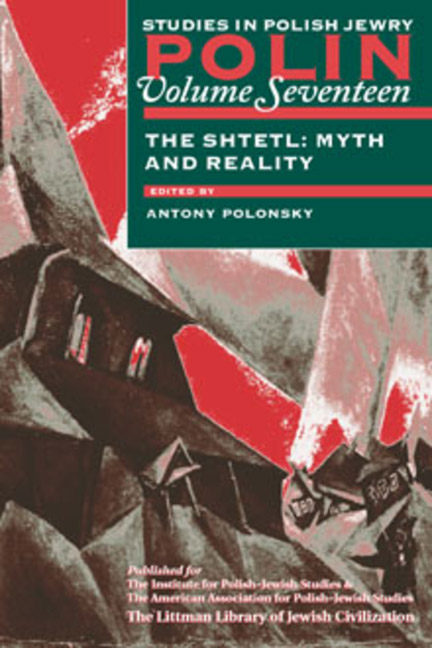Book contents
- Frontmatter
- Dedication
- Editors and Advisers
- Preface
- Polin
- Polin: Studies inPolish Jewry
- Contents
- Note on Place Names
- Note on Transliteration
- List of Abbreviations
- PART I THE SHTETL: MYTH AND REALITY
- Introduction. The Shtetl: Myth and Reality
- The Shtetl as an Arena for Polish–Jewish Integration in the Eighteenth Century
- Inter-Religious Contacts in the Shtetl: Proposals for Future Research
- The Hasidic Conquest of Small-Town Central Poland, 1754–1818
- The Drama of Berdichev: Levi Yitshak and his Town
- Polish Shtetls under Russian Rule, 1772–1914
- How Jewish Was the Shtetl?
- The Changing Shtetl in the Kingdom of Poland during the First World War
- The Shtetl: Cultural Evolution in Small Jewish Towns
- Small Towns in Inter-War Poland
- Jewish Patrons and Polish Clients: Patronage in a Small Galician Town
- Maintaining Borders, Crossing Borders: Social Relationships in the Shtetl
- The Soviet Shtetl in the 1920s
- Shtetl and Shtot in Yiddish Haskalah Drama
- Kazimierz on the Vistula: Polish Literary Portrayals of the Shtetl
- Imagining the Image: Interpretations of the Shtetl in Yiddish Literary Criticism
- Shtetl Codes: Fantasy in the Fiction of Asch, Schulz, and I. B. Singer
- Returning to the Shtetl: Differing Perceptions
- PART II NEW VIEWS
- PART III DOCUMENTS
- PART IV THE SIXTY-FIFTH ANNIVERSARY OF EVENTS IN PRZYTYK: A DEBATE
- PART V REVIEWS
- OBITUARIES
- Notes on the Contributors
- Glossary
- Index
Imagining the Image: Interpretations of the Shtetl in Yiddish Literary Criticism
from PART I - THE SHTETL: MYTH AND REALITY
- Frontmatter
- Dedication
- Editors and Advisers
- Preface
- Polin
- Polin: Studies inPolish Jewry
- Contents
- Note on Place Names
- Note on Transliteration
- List of Abbreviations
- PART I THE SHTETL: MYTH AND REALITY
- Introduction. The Shtetl: Myth and Reality
- The Shtetl as an Arena for Polish–Jewish Integration in the Eighteenth Century
- Inter-Religious Contacts in the Shtetl: Proposals for Future Research
- The Hasidic Conquest of Small-Town Central Poland, 1754–1818
- The Drama of Berdichev: Levi Yitshak and his Town
- Polish Shtetls under Russian Rule, 1772–1914
- How Jewish Was the Shtetl?
- The Changing Shtetl in the Kingdom of Poland during the First World War
- The Shtetl: Cultural Evolution in Small Jewish Towns
- Small Towns in Inter-War Poland
- Jewish Patrons and Polish Clients: Patronage in a Small Galician Town
- Maintaining Borders, Crossing Borders: Social Relationships in the Shtetl
- The Soviet Shtetl in the 1920s
- Shtetl and Shtot in Yiddish Haskalah Drama
- Kazimierz on the Vistula: Polish Literary Portrayals of the Shtetl
- Imagining the Image: Interpretations of the Shtetl in Yiddish Literary Criticism
- Shtetl Codes: Fantasy in the Fiction of Asch, Schulz, and I. B. Singer
- Returning to the Shtetl: Differing Perceptions
- PART II NEW VIEWS
- PART III DOCUMENTS
- PART IV THE SIXTY-FIFTH ANNIVERSARY OF EVENTS IN PRZYTYK: A DEBATE
- PART V REVIEWS
- OBITUARIES
- Notes on the Contributors
- Glossary
- Index
Summary
THE real shtetl may not be easy to define in historical, social, or geographical terms, but as a symbol the shtetl is a constant feature of the Jewish literary imagination. The first modern Yiddish critic, Bal-Makhshoves, made this observation in the opening statement of his seminal essay ‘Dray shtetlekh’ (‘Three Shtetls’, 1913): ‘As one can sense the scent of the grass of the Russian village that comes from Russian literature, or hear the voices of big industrial and commercial cities that fill European literature, so one can perceive in our Yiddish literature the hushed, subdued, and muffled sound of life in a small Jewish shtetl.’ Although the shtetl served as the primary backdrop in nineteenth-century Yiddish literature from Israel Aksenfeld to Y. L. Peretz, it was not until the beginning of the twentieth century that Yiddish critics became aware of its existence as an aesthetic phenomenon. Until then, literary representations of the shtetl were usually perceived as ‘true to life’ depictions, realistic representations of Jewish life in its most concentrated form. The realistic conventions of shtetl fiction were broken most obviously by Sholem Asch in his romantic poem in prose, A Shtetl (1904), which not only brought fame to its young author but also initiated a critical discussion that continues even today. Ironically, the work that provoked so much insightful criticism has fallen into complete disregard. By contrast, the inevitable counterpart to Asch's poem, the naturalistic novella A Shtetl by Yitzhak Meir Weissenberg, has acquired canonical status among contemporary critics and scholars of Yiddish because of its appeal to modern critical sensitivities.
Bal-Makhshoves's essay deals with the image of the shtetl in the works of three leading Polish Yiddish writers: Asch, Weissenberg, and Peretz. Acknowledging the centrality of the shtetl as the primary locus of Yiddish literature, Bal-Makhshoves points out that the real shtetl is rapidly losing its dominant position in Jewish life.
- Type
- Chapter
- Information
- The Shtetl: Myth and Reality , pp. 243 - 258Publisher: Liverpool University PressPrint publication year: 2004

